|
C. C. Hanson
... and the
Hansonhurst Creamery
|
|
|
|
|
|
"Throughout Memphis Charles Clinton Hanson is spoken of in
terms of admiration and respect. His life has been so
varied in its activities, so honorable in its purposes and so
far-reaching and beneficial in its effect that it has become
an integral part of the history of the city and has left an
impression upon the annals of the state."
- from the Barbour County (Alabama) website.
When
Historic-Memphis.com read that paragraph about C. C. Hanson on
the Barbour County website, it was embarrassing to us that
Alabama could speak so highly of a man whom we knew nothing about. This web page is
being developed to correct that
omission. |
 |
|
|
C. C.
Hanson
|
|
|
|
|
|
|
|
|
Click on small
photos to see an enlargement |
|
|
|
|
|
|
|
|
|
|
 |
Charles Clinton
Hanson was
born in 1867 near Opelika, Alabama. His early life was
typical of an Alabama farm boy. His early
education was with the local schools, and although there was no
college for him, he still developed a deep love of literature
and science. Possessing the ability to instill confidence
in others he secured a position as railroad telegraph operator
in Eufaula, Alabama and quickly moved up to become the agent for
the railroads there. Shortly afterwards he accepted a
position as chief clerk of the Ocean Steamship Company and the
Central of Georgia Railroad - both at Savannah, Georgia.
Again he quickly moved forward to "Special agent" for the
railroad and the Steamship Company.
|
|
Opelika, Alabama
|
|
|
|
|
|
To seek wider opportunities Hanson
moved into new areas and eventually to a major position as a
representative of the Cotton Industry. He had originally
leased the cotton compresses of the railroad and steamship companies
and within three years he was head of Atlantic Compress Company in
Atlanta. Not long afterwards he became president of the Gulf
Compress Company, with headquarters in Memphis. |
|
|
 |
 |
 |
 |
 |
|
Telegraph |
Central of Georgia |
Ocean Steamship Co. |
Compress |
Gulf Compress
|
|
|
|
|
|
|
|
|
|
|
|
 |
C. C. Hanson
arrived in Memphis in 1908 at 31 years of age. Everything
was "right" for him in Memphis and in short order he owned
compresses throughout the mid-south, operating them under the
name of Churchill Compresses. He was financially secure.
Because he was so involved in
business one would think he had no time for "volunteer work" or
for Community involvement. Not so at all - Anything that
gained his interest was given his total support. He became
the citizen who was simply into "everything".
Throughout Memphis he is spoken of in terms of admiration and
respect. |
| C. C. Hanson |
|
|
|
|
 |
 |
 |
 |
 |
| Memphis 1908 |
Memphis 1908 |
Memphis 1908 |
Churchill Compress |
Directory |
|
|
|
|
|
|
|
|
|
|
|
|
Hanson must have had the energy of a dozen men because in
Memphis he became involved in so many activities that a weaker
person would have crumbled. No one had a greater respect
for education than he did. For seven years, he was a
member of the State Board of Education, a trustee of the Shelby
County Industrial and Training School, a trustee of Bolton
College. And he was part of the committee who convinced
the state of Tennessee to select Memphis as the site of the
State Normal School. |
 |
| |
Education |
|
 |
 |
 |
 |
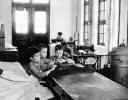 |
 |
|
1910 Report |
1918 School Board |
1919 |
Industrial Training School |
Industrial
Training Students |
Indust Training
|
|
|
|
 |
State Normal School:
In 1909 the
Memphis Board of Education began plans to bring the State Normal
School of West Tennessee to Memphis. A strong committee
was appointed to make this happen. C. C. Hanson was a
"working" member of this committee, and they immediately began
to raise funds. And various building sites were selected.
Competition throughout west Tennessee was tough. In
December the State Board of Education met in Nashville to select
the school's site. Three members of the Memphis committee
were chosen to attend - including C. C. Hanson. After two
days of intense sessions, the state board unanimously awarded
the school site to Memphis. Work began on the school in
1911. When the building was finished, a board of Trustees
was formed and C. C. Hanson became a member of the board. |
| Plans for Normal School |
|
|
|
|
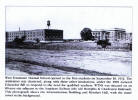 |
 |
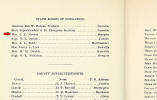 |
 |
 |
| 1912 Construction Photo |
Administrative Bldg. |
1914 Board Member |
1918 Member |
Com Appeal item |
|
|
|
|
|
|
|
|
|
|
|
 |
Bolton College
Prominent land Owner (and Slave Dealer) Wade Bolton set aside
1200 acres for the founding of an agricultural college prior to
his murder in 1869. The school was built on Bolton's
Hoboken Plantation land in 1887 and was active until 1911.
In 1925 it was designated as a secondary school and has remained
that ever since. As Bolton High School, it is one of only
two public schools in Tennessee with its own endowment. C.
C. Hanson lived across the road from Bolton College and along
with Judge J. P. Young, was a
major trustee for the school. Bolton College was located
in Brunswick, Tennessee, better known today as Rosemark or Arlington.
|
| Wade Bolton |
|
|
|
|
 |
 |
 |
 |
 |
 |
| Bolton marker |
Bolton bequest |
Location today |
Location today |
Hoboken |
1919 article |
|
|
|
|
|
|
|
|
|
|
|
|
Hanson was able
to attack everything with such enthusiasm that his vigor was
contagious to all who knew him.
He had a personal library of
over 3,000 books at his home that was equal to the public
libraries - and he allowed students to use it, as well as the
swimming pool on his property. He was President of the
Bureau of Municipal Research ... President of the Memphis
International Business Science Society. He was head of the
Audubon Society for Shelby County and was so devoted to the
preservation of birds that his farm was literally a bird
sanctuary. And there's much more ... |
 |
| |
C. C. Hanson |
|
|
|
 |
 |
 |
 |
 |
|
Library |
Bureau Municipal Research |
Business Science |
Audubon Society |
Bird Sanctuary |
|
|
|
|
|
|
Hanson was President of the
Memphis City Club ... a member of the Chamber of Commerce ...
secretary and treasurer of the Mississippi Valley Compress
Association. The Memphis City Club was actually a "watch
dog" group to see that government was doing their job. It
dealt with specific aspects of city planning and recommended
that various civic groups join to promote he appointment of an
official planning commission. C. C. Hanson was the very
active and well liked president of the City Club. Would
you believe that he also wrote and published the weekly magazine and mailed it without charge to anyone who asked for a
copy? |
 |
| |
City Club Logo
|
|
|
|
 |
 |
 |
 |
 |
 |
| 1919 Article |
1919 Article |
1925 Bulletin |
1925 Bulletin |
1910 Letter |
Club Officers |
|
|
|
|
|
|
|
 |
If the above involvements
weren't enough, Hanson was a Mason, a member of Scottish
Rites...Mystic Shrine...Knights of Pythias ...Knights of
Khorassan... Kiwanis Club ... as well as a member of the
Memphis Country Club.
Plus he wrote articles for the
Business Philosopher Magazine and was an officer of the Union
Planters Bank and the Madison Bank and Trust Co. |
| |
|
|
|
|
 |
 |
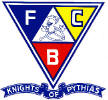 |
 |
 |
| Shriner |
Scottish Rites |
Knights of
Pythias |
Knights of
Khorassan |
Kiwanis Club |
|
|
|
 |
 |
 |
 |
 |
 |
|
Memphis
Country Club 1910 |
Author 1922 |
Author 1922 |
Union Planters |
Madison Bank-Trust |
Madison Bank-Trust |
|
|
|
|
In 2020, Kasie Nolan sent us
the photos on the right along with this message: "This
silver pitcher has been used for Christmas eggnog as long as I
can remember. My grandparents were using it in 1940".
There's an inscription on the bottom of the pitcher, dedicated
to C. C. Hanson from Ancient and Accepted Scottish Rite:
|
 |
 |
| |
Silver Pitcher |
Dedication |
|
|
|
|
The dedication reads:
Presented to C. C. Hanson 32o
. by the Officers of Oct 1910 Class of
A.A.S.R as a token of their brotherly love and regard and for
services rendered our class. E. S. Brown - Pres, W. G. Erskine
- Vice Pres, Chas Rasenhul, 2nd Vice Pres, Billing Sibley - Sec, A.
E. Piison - Treas, W. L. Stooksbury -Orator, Chas E. Popoweh -
Associate Orator. |
|
|
|
|
|
|
|
|
 |
In addition C. C. Hanson was
happily married to Adele M. Shorter in 1889. She is the
daughter of Col. Henry R. Shorter, of the distinguished Alabama
family. There are reports that Mrs. Hanson is "the
most queenly woman" you'll ever meet. The Hanson's live across the road from
Bolton College in a home called "Bide-a-wee". At this
time, we have not been able to locate any information
about children. |
| |
| |
 |
 |
 |
| |
1919 Article |
1919 Article |
1920 Article |
|
|
|
|
|
|
|
And then there was "Hansonhurst"
and "Hansonhurst Creamery"
In 1922, C. C. Hanson built the
Hansonhurst Creamery on his property at Brunswick, thirty miles
northeast of Memphis. It was built with the best modern
equipment to manufacture butter, ice cream and cheese which was delivered daily to Memphis by
4 trucks which were purchased for this service. Hanson
purchased cream from local farms and the Creamery could turn out
6,000 pounds of butter a day. It was served by a two floor
ice plant with 25 tons of refrigeration, along with a 35,000
gallon water tower. |
 |
| |
Hansonhurst 1922 |
|
|
|
|
The Creamery was part of a
master plan to build Hansonhurst, a model community that would have
greater wealth, per capita, than any other town in the nation.
To call attention to the community, he placed a checkerboard marker
at every curve along the crooked road to Hansonhurst. The
primary business was the Creamery. Future plans called for
building an entire model community with large estates, several
stores, a large dairy plant, refrigeration plant, a cotton gin,
large swimming pool, and a small amusement park. At the
opening were the Hansonhurst Service Store which sold standard
merchandise at chain store prices, the Hansonhurst Creamery,
the ice plant, warehouse, and the pool. |
 |
| |
Creamery article 1922 |
|
|
|
 |
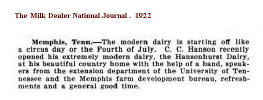 |
 |
| Creamery
article 1921 |
Creamery article 1922 |
Radio article
1922 |
|
|
|
|
|
The pool was 40 x 100, to a
depth of 12 feet at the deep end. It was located between
the Creamery garage and the Churchill Warehouse. It was
open from early morning to 9 PM. Showers and dressing
rooms were also available. The original charge was 15 cents which
included the use of a "sterilized bathing suit". The pool
was surrounded by grass lawns, walks, flowers and shrubbery.
There were plans to add a bowling alley next to the pool, but it
was never built. |
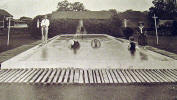 |
| |
Hansonhurst Pool 1922 |
|
|
|
 |
 |
 |
 |
|
Aerial View 1922 |
Opening Day 1922 |
Hansonhurst 1922 |
Hansonhurst trucks 1922 |
|
|
|
|
Email from John Gmail:
2/23/2019:
"...just thought you might
be interested in knowing about the Hansonhurst Silent Theater.
It was over the ice plant and I have been there when the ammonia
from the ice plant below would come up and make it hard to breathe.
I was just about 7 or 8 - born in 1920. The long building on
the right was a dance hall." |
|
|
|
|
 |
 |
 |
 |
 |
 |
|
Hansonhurst Pool 1922 |
1925 ad |
1922 ad |
Employees 1922 |
1922 Bulletin |
1924 Directory |
|
|
|
 |
Hansonhurst may have been built at the wrong time and it was never completed.
It failed in 1929, with the hit of the Great Depression, and
went into foreclosure. At that time, in addition to the
original structures, only 5 homes had been built, along with 3
stores, a silent movie theater, bird sanctuary, and a dance
pavilion. In 1930, everything was sold at auction for $30,000.
Today you can drive by Hansonhurst without knowing you've been
there. |
|
Foreclosure ! |
|
|
|
|
|
We have not been able to locate any
additional information on C. C. Hanson after the failure of
Hansonhurst - no obituary or grave. It appears that the paper
trail literally stopped after that. Hopefully viewers of this page will have more
information?
|
|
|
|
|
|
|
|
|
|
|
|
|
|
|
Credits |
|
|
|
The
Historic-Memphis website does not intentionally post copyrighted
photos and material without permission or credit.
On
occasion a "non-credited" photo might possibly be posted because we
were unable to find a name to give credit. Because of the nature of
our non-commercial, non-profit, educational website, we strongly
believe that these photos would be considered "Fair Use. We have
certainly made no monetary gain, although those using this website
for historic or Genealogy research have certainly profited. If by
chance,
we have posted your copyrighted photo, please contact us, and we'll
remove it immediately, or we'll add your credit if that's your
choice. In the past, we have found that many photographers
volunteer to have their works included on these pages and we'll
also do that if you contact us with a photo that fits a particular
page. |
|
|
|
The "Historic-Memphis" website would like to acknowledge and thank the
following for their contributions which helped make this website
possible: Memphis
Public Library, Memphis University Library, Memphis Law Library,
Memphis Commercial Appeal, Memphis Press Scimitar, Shelby County
Register of Deeds, Memphis Business Men's
Club, Memphis Chamber of Commerce, Memphis Heritage Inc, Beale Street Historic District,
Cobblestone Historic District, Memphis Historic Districts, Vance
Lauderdale Family Archives, Tennessee State Archives, Library of
Congress, Lee Askew,
George Whitworth, Woody Savage and many individuals whose assistance is
acknowledged on the pages of their contributions. Special
thanks to Memphis Realtor, Joe Spake, for giving us carte blanche
access to his outstanding collection of contemporary Memphis photos.
We do not have high definition copies of the photos on these
pages. If anyone wishes to secure high definition photos,
you'll have to contact the photographer or the collector.
(To avoid any possibility of contributing to SPAM, we do not
maintain a file of email addresses for anyone who contacts us). |
|
|
|
|
|
|
|
|
|
|
|
|
|
|
|
|
|
|
| |
|
|